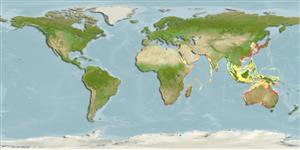Environment: milieu / climate zone / depth range / distribution range
Ecología
marino; salobre bentopelágico; oceanodromo (Ref. 51243). Tropical; 40°N - 39°S, 18°E - 155°E
Indo-West Pacific: African southeast coast from Cape of Good Hope to southern Mozambique; northern Indian Ocean off Pakistan and northwest coast of India; northern Pacific from southern Korea and Japan, along the Chinese coast to Hong Kong; in Australia along the entire southern seaboard from North West Cape (north of Shark Bay) in Western Australia to the Burnett River (north of Brisbane) in Queensland.
Length at first maturity / Tamaño / Peso / Age
Maturity: Lm 100.0 range ? - ? cm
Max length : 181 cm TL macho / no sexado; (Ref. 11025); peso máximo publicado: 75.0 kg (Ref. 11025)
Espinas dorsales (total): 10 - 11; Radios blandos dorsales (total): 25-30; Espinas anales 2; Radios blandos anales: 7; Vértebra: 25. In life, silvery grey becoming darker above and lighter below. Dorsal surface with a bluish bronze sheen that may become coppery on head. Preserved specimens vary in color according to treatment; usually grey but sometimes brown; darker above and lighter below (Ref 11025).
Adult fish found mainly near shore beyond the surf zone, occasionally going inshore. Juveniles exclusively found inshore. Juveniles recruit to estuaries at about 30 cm TL. An important food fish (Ref. 11025).
Griffiths, M.H. and P.C. Heemstra, 1995. A contribution to the taxonomy of the marine fish genus Argyrosomus (Perciformes: Sciaenidae), with descriptions of two new species from southern Africa. Ichthyol. Bull., J.L.B. Smith Inst. Ichthyol. No. 65, 40 p. (Ref. 11025)
IUCN Red List Status (Ref. 130435)
Threat to humans
Harmless
Human uses
Pesquerías: comercial; Acuicultura: comercial; pesca deportiva: si
Más información
ReferenciasAcuiculturaPerfil de acuiculturaRazasGenéticaElectrophoresesheritabilidadEnfermedadesProcesamientoNutrientsMass conversion
ColaboradoresImágenesStamps, Coins Misc.SonidosCiguateraVelocidadTipo de nataciónSuperficie branquialOtolitosCerebrosVisión
Herramientas
Special reports
Download XML
Fuentes de Internet
Estimates based on models
Preferred temperature (Ref.
123201): 16.7 - 27.8, mean 25.3 °C (based on 600 cells).
Phylogenetic diversity index (Ref.
82804): PD
50 = 0.5020 [Uniqueness, from 0.5 = low to 2.0 = high].
Bayesian length-weight: a=0.00977 (0.00536 - 0.01781), b=3.07 (2.92 - 3.22), in cm total length, based on LWR estimates for this species & (Sub)family-body (Ref.
93245).
Nivel trófico (Ref.
69278): 4.5 ±0.6 se; based on diet studies.
Resiliencia (Ref.
120179): Bajo, población duplicada en un tiempo mínimo de 4.5-14 años (tm=6; tmax=40; K=0.03-0.24; Fec=900,000-1 million).
Fishing Vulnerability (Ref.
59153): High to very high vulnerability (66 of 100).
Nutrients (Ref.
124155): Calcium = 31.8 [11.0, 130.0] mg/100g; Iron = 0.454 [0.150, 1.331] mg/100g; Protein = 18.8 [16.7, 20.8] %; Omega3 = 0.215 [0.105, 0.385] g/100g; Selenium = 63 [19, 250] μg/100g; VitaminA = 23.8 [7.9, 76.3] μg/100g; Zinc = 0.725 [0.498, 1.095] mg/100g (wet weight);
